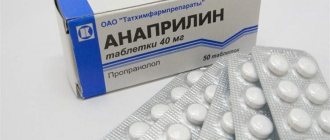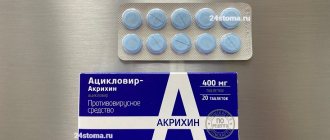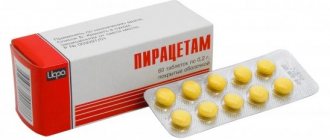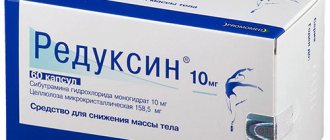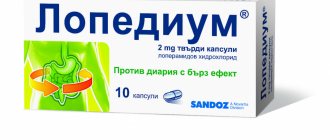Anaprilin is the first developed representative of the group of beta-blockers, the action of which is aimed at stabilizing blood pressure levels. Based on the drug intake, specialists can judge the effectiveness of new medications of this class. As a rule, patients take Anaprilin for blood pressure, but the drug has an additional antiarrhythmic effect, helping to normalize cardiac activity in people with vascular disorders. At what pressure levels can you take the drug and how to dose it correctly to avoid negative effects?
General characteristics of the product
Anaprilin for blood pressure belongs to the group of non-selective beta-adrenergic receptor blockers. The medicine has antiarrhythmic, hypotensive, antiangial properties, due to which it effectively lowers blood pressure without placing additional stress on the myocardium.
After taking a single dose of the drug, a decrease in systolic and diastolic pressure is observed, both in horizontal and vertical positions
Regular use of the medication allows you to achieve the following results:
- reduce the automaticity of the sinus node;
- reduce the excitability of the heart muscle;
- prevent the occurrence of ectopic contractions;
- normalizes the frequency of contractions of the heart muscle;
- inhibits atrioventricular conduction;
- reduces the oxygen demand of cardiomyocytes.
By blocking adrenergic receptors, anaprilin reduces blood pressure in hypertension resulting from disruption of the endocrine and excretory systems (essential and renal hypertension).
Pharmacodynamics and pharmacokinetics
The main active ingredient is propranolol . Anaprilin is a non-selective adrenergic blocker, reduces the sympathetic effect on beta-adrenergic receptors of the heart, reduces the frequency and strength of heart contractions, reduces the contractile function of the myocardium, regulates cardiac output downwards, blocks the positive inotropic and chronotropic effect of catecholamines, reduces the heart's need for oxygen, reduces arterial pressure. The mechanism of action of the drug is aimed at increasing bronchial tone through blockade of beta2-adrenergic receptors. Anaprilin increases the contractility of the uterus, reduces the risk of bleeding during childbirth, the postpartum and postoperative periods.
When taken orally, the drug is quickly absorbed and excreted from the body. The maximum peak content of the active substance in the blood plasma is recorded after 1 -1.5 hours. The drug penetrates the fetoplacental barrier.
Composition and release forms
Anti-pressure tablets Anaprilin are available in dosages of the active substance in concentrations of 10 and 40 mg. To date, an injection form of the product has been developed, which is available in ampoules of 0.25%.
The medication is available in a plastic jar, which can contain 10, 40, 50, 60, 100 tablets.
The active substance in the drug is propranolol hydrochloride, which is used to lower blood pressure levels. The composition also includes additional components:
- microcrystalline cellulose;
- calcium stearate;
- talc;
- corn starch;
- colloidal silicon dioxide;
- hypromellose.
A wide range of dosages of tablet forms of the drug makes it possible for patients to select the required amount depending on the prescribed dosage regimen.
Treatment regimen with "Anaprilin"
The drug is prescribed according to indications and average therapeutic doses for each pathology.
Features of application:
- The frequency of administration is at least 2 times a day (due to the short half-life: 4-6 hours).
- Take tablet forms and capsules 10-30 minutes before meals with a sufficient amount of liquid.
- Dose adjustment is carried out no less than 2 weeks from the start. Monitoring effectiveness - daily measurement of blood pressure and pulse rate before dose selection. After stabilization of indicators - once a week.
- Weekly monitoring of blood glucose levels is recommended at the beginning of treatment.
- The dose selection scheme for the patient begins with the average therapeutic dose (calculated per kilogram of body weight). After 10-14 days, assess the effectiveness; if the desired result is not achieved, reduce or increase by 50% (do not exceed the maximum daily dose of 320 mg).
Most often, “Anaprilin” is prescribed for lifelong use; the duration of therapy for infantile hemangioma is 6-8 months.
Modern analogues of the drug
The modern pharmaceutical industry offers the patient a wide choice of drugs in a convenient release form and an acceptable price category.
The most common Anaprilin analogues are presented in the table.
| Tradename | Release form |
| "Obzidan" |
|
| "Propranolol" |
|
| "Inderal" |
|
| "Anaprilin" |
|
| "Hemangiol" |
|
| "Propranobene" |
|
| "Vero-Anaprilin" |
|
The presence of contraindications and restrictions for use in patients with concomitant endocrine or ophthalmological pathologies requires the selection of a high-quality substitute. The most common selective blockers prescribed in cardiologist practice are: Bisoprolol, Metoprolol, Labetalol, Nebivolol.
The selection of the drug is carried out depending on the patient’s sensitivity to the active substance, the availability of the required dosage in domestic or imported products.
For what conditions is it used?
The blood pressure medicine Anaprilin is prescribed by a specialist when diagnosing the following conditions:
- Increased blood pressure due to essential or symptomatic hypertension.
- Treatment of coronary heart disease, angina pectoris, myocardial infarction after stabilization of vital signs.
- Irregular heart rhythm with a significant increase in heart rate.
- A disorder of the autonomic nervous system, when patients experience frequent attacks of panic attacks.
- Portal hypertension due to liver cirrhosis.
- Essential tremor.
The drug is effective in the initial stages of hypertension, therefore suitable for treating young patients
The drug is prescribed for high blood pressure, when the disease is complicated by left ventricular hypertrophy and rhythm disturbances. In addition, the drug serves as an effective prevention of migraine, which accompanies attacks of arterial hypertension.
Pharmacological properties
After taking the drug, B-adrenergic receptors are inhibited, resulting in a decrease in the intracellular concentration of calcium ions, due to which the heart rate slows down, myocardial excitability decreases, and the number of heart contractions decreases.
Due to its antiarrhythmic effect, regular use of the drug helps reduce the number of deaths after a heart attack
What pharmacological effect can be achieved with regular use of the medication:
- Hypotensive. Helps reduce minute blood volume, reduces upper and lower pressure, stimulates peripheral vessels. Reduces the activity of the renin-angiotensin system in patients with impaired renal function. The therapeutic effect is achieved 14 days after administration.
- Antianginal. Reduces the need of heart cells for oxygen, slows down the heart rate, thereby improving the capacity of the heart. However, in patients with chronic heart failure, myocardial oxygen demand may increase, which is due to increased diastolic pressure in the left ventricle.
- Antiarrhythmic. Reduces the increased activity of the sympathetic nervous system, prevents spontaneous excitability of the sinus pacemaker. By reducing the heart's need for oxygen, ischemic manifestations are reduced.
The active components are quickly absorbed into the bloodstream, due to which the pressure stabilizes in a short time. Propranolol is excreted by the kidneys in the form of metabolites.
Anaprilin
When used simultaneously with hypoglycemic agents, there is a risk of developing hypoglycemia due to the increased effect of hypoglycemic agents.
When used simultaneously with MAO inhibitors, there is a possibility of developing undesirable manifestations of drug interactions.
Cases of the development of severe bradycardia have been described when using propranolol for arrhythmia caused by digitalis drugs.
When used simultaneously with drugs for inhalation anesthesia, the risk of suppression of myocardial function and the development of arterial hypotension increases.
When used simultaneously with amiodarone, arterial hypotension, bradycardia, ventricular fibrillation, and asystole are possible.
When used simultaneously with verapamil, arterial hypotension, bradycardia, and dyspnea are possible. Cmax in the blood plasma increases, AUC increases, and the clearance of propranolol decreases due to inhibition of its metabolism in the liver under the influence of verapamil.
Propranolol does not affect the pharmacokinetics of verapamil.
A case of severe arterial hypotension and cardiac arrest has been described when used simultaneously with haloperidol.
When used simultaneously with hydralazine, the Cmax in the blood plasma and the AUC of propranolol increase. It is believed that hydralazine may reduce hepatic blood flow or inhibit the activity of liver enzymes, resulting in a slower metabolism of propranolol.
When used simultaneously, propranolol can inhibit the effects of glibenclamide, glyburide, chlorpropamide, tolbutamide, because Non-selective beta2-blockers are able to block pancreatic beta2-adrenergic receptors associated with insulin secretion.
The release of insulin from the pancreas due to the action of sulfonylurea derivatives is inhibited by beta-blockers, which to some extent prevents the development of the hypoglycemic effect.
When used simultaneously with diltiazem, the concentration of propranolol in the blood plasma increases due to inhibition of its metabolism under the influence of diltiazem. An additive depressant effect on cardiac function is observed due to the slowing of impulse conduction through the AV node caused by diltiazem. There is a risk of developing severe bradycardia, stroke and minute volume are significantly reduced.
With simultaneous use, cases of increased concentrations of warfarin and phenindione in the blood plasma have been described.
When used concomitantly with doxorubicin, experimental studies have shown increased cardiotoxicity.
When used simultaneously, propranolol prevents the development of the bronchodilator effect of isoprenaline, salbutamol, and terbutaline.
With simultaneous use, cases of increased concentrations of imipramine in the blood plasma have been described.
When used simultaneously with indomethacin, naproxen, piroxicam, acetylsalicylic acid, the antihypertensive effect of propranolol may be reduced.
When used simultaneously with ketanserin, an additive hypotensive effect may develop.
When used simultaneously with clonidine, the antihypertensive effect is enhanced.
In patients receiving propranolol, severe arterial hypertension may develop if clonidine is abruptly discontinued. It is believed that this is due to an increase in the content of catecholamines in the circulating blood and an increase in their vasoconstrictor effect.
When used simultaneously with caffeine, the effectiveness of propranolol may be reduced.
With simultaneous use, it is possible to enhance the effects of lidocaine and bupivacaine (including toxic ones), apparently due to a slowdown in the metabolism of local anesthetics in the liver.
When used simultaneously with lithium carbonate, a case of bradycardia has been described.
With simultaneous use, a case of increased side effects of maprotiline has been described, which is apparently due to a slowdown in its metabolism in the liver and accumulation in the body.
When used simultaneously with mefloquine, the QT interval increases, and a case of cardiac arrest has been described; with morphine - the inhibitory effect on the central nervous system caused by morphine is enhanced; with sodium amidotrizoate - cases of severe arterial hypotension have been described.
When used simultaneously with nisoldipine, an increase in the Cmax and AUC of propranolol and nisoldipine in the blood plasma is possible, which leads to severe arterial hypotension. There is a report of increased beta-blocking action.
Cases of increased Cmax and AUC of propranolol, arterial hypotension and a decrease in heart rate have been described when used simultaneously with nicardipine.
When used simultaneously with nifedipine in patients with coronary artery disease, severe arterial hypotension may develop, increasing the risk of heart failure and myocardial infarction, which may be due to an increase in the negative inotropic effect of nifedipine.
Patients receiving propranolol are at risk of developing severe hypotension after taking the first dose of prazosin.
When used simultaneously with prenylamine, the QT interval increases.
When used simultaneously with propafenone, the concentration of propranolol in the blood plasma increases and a toxic effect develops. Propafenone is believed to inhibit the hepatic metabolism of propranolol, reducing its clearance and increasing serum concentrations.
With the simultaneous use of reserpine and other antihypertensive drugs, the risk of developing arterial hypotension and bradycardia increases.
With simultaneous use, the Cmax and AUC of rizatriptan increases; with rifampicin - the concentration of propranolol in the blood plasma decreases; with suxamethonium chloride, tubocurarine chloride - the effect of muscle relaxants may change.
With simultaneous use, the clearance of theophylline decreases due to a slowdown in its metabolism in the liver. There is a risk of developing bronchospasm in patients with bronchial asthma or COPD. Beta blockers may block the inotropic effect of theophylline.
When used simultaneously with phenindione, cases of a slight increase in bleeding without changes in blood clotting parameters have been described.
When used concomitantly with flecainide, additive cardiodepressive effects are possible.
Fluoxetine inhibits the CYP2D6 isoenzyme, which leads to inhibition of the metabolism of propranolol and its accumulation and may enhance the cardiodepressive effect (including bradycardia). Fluoxetine and, mainly, its metabolites are characterized by a long T1/2, so the likelihood of drug interactions remains even several days after discontinuation of fluoxetine.
Quinidine inhibits the CYP2D6 isoenzyme, which leads to inhibition of the metabolism of propranolol, while its clearance decreases. Increased beta-blocking action and orthostatic hypotension are possible.
With simultaneous use in the blood plasma, the concentrations of propranolol, chlorpromazine, and thioridazine increase. A sharp decrease in blood pressure is possible.
Cimetidine inhibits the activity of microsomal liver enzymes (including the CYP2D6 isoenzyme), this leads to inhibition of the metabolism of propranolol and its cumulation: an increase in negative inotropic effect and the development of a cardiodepressive effect are observed.
With simultaneous use, the hypertensive effect of epinephrine is enhanced, and there is a risk of developing severe life-threatening hypertensive reactions and bradycardia. The bronchodilator effect of sympathomimetics (epinephrine, ephedrine) decreases.
With simultaneous use, cases of decreased effectiveness of ergotamine have been described.
There are reports of changes in the hemodynamic effects of propranolol when used simultaneously with ethanol.
Mechanism of action in hypertension
Before starting a therapeutic course, patients are interested in the question of the effectiveness of the prescribed medication, and does it reduce blood pressure at high levels?
The hypotensive mechanism of action of this drug is due to its ability to block beta-adrenergic receptors of the myocardium and other tissues, which is an integral part of lowering blood pressure. Inhibition of renin production contributes to decreased secretion of angiotensin 2, which leads to a decrease in blood pressure and determines the effectiveness of the antihypertensive effect of pills.
Mechanism of action of the drug for hypertension
The vasodilating effect of Anaprilin is based on the following mechanisms:
- impact on vascular receptors;
- pronounced adrenergic blocking activity;
- increases the release of nitric oxide from endothelial cells;
- expansion of the vascular lumen;
- increased production of vasodilating factors (prostaglandins, prostacyclins);
- decreased production of norepinephrine by sympathetic nerve fibers;
- decreased permeability of blood vessels to potassium and sodium ions.
Selection of the optimal dose
Before starting a treatment course, the patient needs to determine the daily dose of the drug, which will help eliminate hypertension and ensure stable blood pressure and pulse rate. It will also determine whether or not the drug can be used at elevated blood pressure levels when the heart rate is normal.
The dosage and frequency of administration are determined depending on the severity of hypertension, the presence of concomitant pathologies and the age of the patient
It is possible to achieve a decrease in pressure much later than normalization of sinus rhythm, which depends on the concentration of the active substance. It is recommended to take Anaprilin for high blood pressure with a full treatment course of at least 21 calendar days. The intervals between doses are 1–2 months.
The dosage of the drug depends on the indications:
- With high blood pressure. The starting dose of the drug is 80 mg, which must be divided into 2 doses. If the drug does not reduce blood pressure, the dosage is increased to 120–160 mg per day, that is, 40 mg should be taken in 3–4 doses.
- With high heart rate. At the initial stage of treatment, the daily dose is divided into 20 mg, which are drunk 3 times a day. In the absence of a therapeutic effect, the dose is increased to 80–120 mg per day.
With a normal number of heartbeats and high blood pressure, the drug is used to prevent migraine attacks and tremor. The starting dose is 20 mg 3 times a day, and the maximum allowable dose is 160 mg.
The drug Anaprilin - reviews
Tayra
https://otzovik.com/review_1314196.html
I have mixed opinions about this drug. I took it for the first time almost 13 years ago. Then it helped me a lot against tachycardia. I took the course for no more than 3 weeks. I did not observe any side effects.
The cardiologist prescribed me anaprilin again 2 years ago (more precisely, it was prescribed as a replacement for a drug that was no longer available in pharmacies). Without hesitation, I purchased and began taking it according to the regimen indicated by the doctor. As a result, I received a whole group of side effects. Namely, severe weakness, very low blood pressure (even though I took a small dose of the drug), fatigue. In general, I had to stop taking anaprilin ahead of schedule.
As for one-time help, as neurologists sometimes advise, I can’t say much - yes, it slows down the pulse, but it won’t solve the problem!
I won’t recommend it because I’m not happy with the side effects at all.
Mireya
https://otzovik.com/review_510788.html
I first tried anaprilin when the emergency doctor discovered that I had high blood pressure (120*90), (my normal blood pressure is 110*70). He gave me an anaprilin tablet and told me to put the tablet under my tongue. According to him, anaprilin acts faster this way.
What I would like to note is that yes... my blood pressure dropped to 90*60, but for me this is already too much... And what’s more, I burned the mucous membrane of my tongue with anaprilin, and the dry mouth did not go away for a long time. After one anaprilin tablet, I treated my tongue with olive oil for a week, since it did not want to obey me and was very painful. I had difficulty chewing food. The skin was peeling off the tongue...
Now I’ll think next time whether to take anaprilin or not. Thanks to bitter experience... Most likely I did something wrong when I took anaprilin, although it seemed like I was only following the doctor’s orders from the ambulance...
Milkiboy
https://otzovik.com/review_4515745.html
Greetings, dear readers, we all know about a drug called Anaprilin “every grandmother has them on hand”, but I will not talk about their direct purpose, but about the fact that with their help you can fight fear...
I myself am very shy, I often experience panic attacks, I had difficulty communicating with the opposite sex...
On the Internet, in search of a solution to my problem, I found a description of these tablets. Indeed, after taking it, I felt some relief and was not so afraid to communicate with people I didn’t know, panic attacks became significantly less
And so let's move on to the method of reception:
Place two tablets under your tongue and hold them until you feel slight weakness and an incomprehensible calmness; as soon as you feel this, spit out the remaining medication and rinse your mouth with water. “Do not swallow saliva or the tablets themselves.”
I also do not recommend abusing Anaprilin because this will lead to a worsening of the situation and also heart problems.
kotenych
https://irecommend.ru/content/pomogaet-ot-volneniya-v-slozhnykh-situatsiyakh-primenyat-s-ostorozhnostyu
Hi all.
I’ll say right away that I didn’t use Anaprilin for its intended purpose, since I don’t have any problems with my heart or blood pressure. But I had the opportunity to experience in practice its other properties, which not everyone knows about.
But first, a little theory (here please correct me if I make mistakes). Anaprilin is an adrenaline receptor blocker. In a stressful situation, this same adrenaline is released in the body in large quantities and begins to affect our body. This is where the physical reaction to stress comes from when it is strong enough: sweating, flushing, trembling hands, rapid heartbeat. Anaprilin blocks these receptors, and they become insensitive to adrenaline. That is, all (or many) physical symptoms disappear (or weaken), and you can behave adequately.
Therefore, Anaprilin can be used in situations such as interviews, public speaking, important exams, etc. Usually 40 mg is enough (but you should always try to get by with a smaller dose). If you don’t swallow it, but put it under your tongue, then 10-20 mg is enough.
I want to warn those who were delighted and ran to buy!
Anaprilin is a heart medicine, so it should be used with extreme caution. You can drink it as rarely as possible and only for a serious reason. Firstly, tolerance to it develops very quickly, meaning you will need to constantly increase the dose to get any effect. I highly do not recommend drinking more than 60-80 mg at a time! Secondly, if taken frequently, you can get serious heart problems. So, no more than a couple of times a month and no more than 40 mg at a time.
Nadezhda S
I couldn’t believe my eyes when 4 years ago I was prescribed Anaprilin to prevent migraines. It was recommended to me back in my senior year. Although we didn’t have the Unified State Exam then, we were no less worried. Since the middle of the year, I began to experience tachycardia when hearing the word “exam,” and in the end, looking at my redness and paleness, they sent me to the hospital. As a result, I took these pills for some time to normalize the nervous system itself with valerian in pills. Now I remember - that would be something to worry about. Graduated with 2 or 3 B's. Apparently, I have an excellent student complex, which I have almost overcome by now, resorting to therapy of common sense and not caring about what is happening :)
And so I was prescribed Anaprilin for migraines. At that time, I had a headache at least once a week, for three days. Sometimes it happened like this: 3rd headache, then 2nd it doesn’t hurt, and then it hurts again.
I drank them for a while but didn’t find any significant changes. There was still a positive change, which is why I give it 5 stars out of 10. The interval between headaches has increased to an average of 5-6 days. That is, the total number of attacks per month decreased, but the migraine itself also tormented me for three days, and the strength of these pains did not decrease.
After the next appointment, the doctor realized that this effect did not suit me or her, she canceled Anaprilin and allowed me to take sumatriptan drugs. They didn’t cause headaches any less often, but there was a real opportunity to relieve the pain for 12 hours.
Elena Lyubimova
Anaprilin was prescribed to me by a doctor several years ago. This medicine is very accessible and inexpensive. I had a slight heart rhythm disturbance, that is, signs of arrhythmia and migraine. The doctor who prescribed this drug was young and inexperienced, and at that time I didn’t particularly understand drugs.
After taking the first tablets, I felt bad and I began to study the instructions for using Anaprilin. In the end, I found the reason myself. The thing is that I always have low blood pressure, and Anaprilin also lowers it. That's why I felt bad. And the doctor who prescribed me the drug Anaprilin simply did not take this into account.
As far as I know, according to the stories of acquaintances and friends, Anaprilin is a good drug, it helps a lot in the treatment of arrhythmia and tachycardia, it just didn’t suit me at all. Before taking Anaprilin, you must carefully study the instructions and take into account contraindications so as not to end up in the same situation as me. It’s also good that I stopped taking this medication at the right time.
Galinka Malinka
I take anaprilin tablets very rarely in order to quickly lower my blood pressure. If you have high blood pressure, emergency doctors and your local physician recommend taking anaprilin.
Anaprilin acts faster if you put it under the tongue, but there is a chance of burning the mucous membrane under the tongue. I myself have encountered this problem, and therefore I put anaprilin tablets under my tongue and wash them down with a little water to further relieve dryness and burning in my mouth.
The price and cost of anaprilin tablets is affordable. You can buy anaprilin at a pharmacy without a prescription. Instructions for anaprilin are included with the tablets without fail.
Reviews about anaprilin tablets are different, so read and draw the appropriate conclusions for yourself...
For those who are not suitable for anaprilin, emergency doctors also advise taking capoten (captopril), capoten (captopril) tablets have a sour taste and do not cause such a burning sensation as anaprilin. The action of anaprilin and capoten is the same.
Be healthy and watch your blood pressure! Now you can measure your blood pressure for free in any pharmacy. After all, it is better to prevent a disease than to treat it for a long time and sometimes unsuccessfully...
Features of drug cancellation
If it is necessary to take a break from treatment with Anaprilin, the dose should be reduced gradually until complete withdrawal, since abrupt cessation of use of the drug can cause withdrawal syndrome.
Abrupt refusal to take medication can cause an attack of angina, tachycardia and increased blood pressure
Experts recommend discontinuing the use of the medication in the following cases:
- Reducing the number of heart contractions to 50 beats/min.
- At low pressure, when systolic blood pressure drops to 100 mm. rt. Art.
- Development of bronchial spasm.
- Disturbance in the functioning of the liver excretory system.
- Depressive state.
- Ventricular arrhythmia.
The optimal withdrawal period is considered to be 14 days from the moment the patient reduces the dosage until the patient completely stops using the tablets. As a rule, the dose is reduced by 10–40 mg every 6–7 days.
special instructions
The use of the drug during pregnancy is permitted in cases where the benefits to the woman’s body outweigh the potential risks to the fetus. During the treatment course, it is necessary to constantly monitor the child’s condition, since the following complications may occur:
- decrease in the number of heart contractions;
- decrease in glucose concentration in the bloodstream;
- intrauterine growth retardation.
A few days before the expected birth, Anaprilin should be discontinued.
Active substances are absorbed into breast milk, so women should switch their baby to artificial feeding
Elderly patients should take the drug with caution. Thus, once every three months, the concentration of glucose in the bloodstream of diabetics is monitored and the functional state of the kidneys is monitored.
Side effects
If recommendations for dosing of the drug are not followed, side effects from various systems may occur:
- Cardiovascular (circulatory disorders, arterial hypotension, increasing symptoms of heart failure).
- Hematopoietic (leukopenia, thrombocytopenia).
- Nervous (sleep disorder, dizziness, depression, malaise).
- Respiratory (coughing attacks, shortness of breath, pharyngitis, bronchospasm).
- Gastrointestinal (nausea, vomiting, diarrhea, pain in the epigastric region).
- Skin manifestations (rashes, itching, partial hair loss).
- Visual tract (dry eye mucosa, pain, decreased visual acuity).
Today, Anaprilin remains one of the most common and effective antihypertensive drugs, which at the same time help normalize heart rhythm. However, the medicine has a number of negative effects that affect the activity of all organs and systems. Therefore, for arterial hypertension, the course of treatment should be accompanied by periodic intervals that prevent a decrease in sensitivity to the active components and reduce the number of side effects.
Side effects
Bradycardia , atrioventricular block, bronchiolospasm, the development of Raynaud's syndrome , heart failure, vomiting, muscle weakness , epigastric pain, vomiting, diarrhea , itching , depression , hypoglycemia - of diabetes are noted. diabetes , visual impairment, decreased potency.
